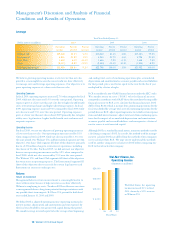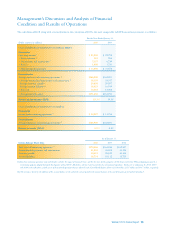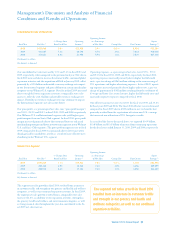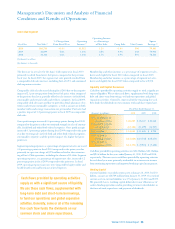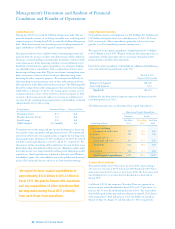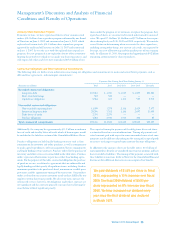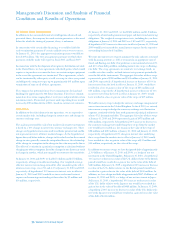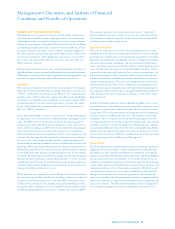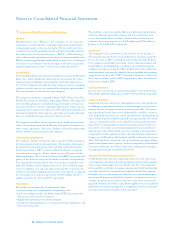Walmart 2010 Annual Report Download - page 29
Download and view the complete annual report
Please find page 29 of the 2010 Walmart annual report below. You can navigate through the pages in the report by either clicking on the pages listed below, or by using the keyword search tool below to find specific information within the annual report.Summary of Critical Accounting Policies
Management strives to report the financial results of the company in a
clear and understandable manner, although in some cases accounting
and disclosure rules are complex and require us to use technical termi-
nology. In preparing our Consolidated Financial Statements, we follow
accounting principles generally accepted in the United States. These
principles require us to make certain estimates and apply judgments
that affect our financial position and results of operations as reflected in
our financial statements. These judgments and estimates are based on
past events and expectations of future outcomes. Actual results may
differ from our estimates.
Management continually reviews our accounting policies, how they are
applied and how they are reported and disclosed in our financial statements.
Following is a summary of our more significant accounting policies and
how they are applied in preparation of the financial statements.
Inventories
We value our inventories at the lower of cost or market as determined
primarily by the retail method of accounting, using the last-in, first-out
(“LIFO”) method for substantially all our Walmart U.S. segment’s mer-
chandise. Sam’s Club merchandise and merchandise in our distribution
warehouses are valued based on weighted-average cost using the LIFO
method. Inventories for international operations are primarily valued
by the retail method of accounting and are stated using the first-in,
first-out (“FIFO”) method.
Under the retail method, inventory is stated at cost, which is determined
by applying a cost-to-retail ratio to each merchandise grouping’s retail
value. The FIFO cost-to-retail ratio is based on the initial margin of
beginning inventory plus the fiscal year purchase activity. The cost-to-
retail ratio for measuring any LIFO reserves is based on the initial margin
of the fiscal year purchase activity less the impact of any markdowns.
The retail method requires management to make certain judgments and
estimates that may significantly impact the ending inventory valuation
at cost as well as the amount of gross profit recognized. Judgments
made include recording markdowns used to sell through inventory and
shrinkage. When management determines the salability of inventory has
diminished, markdowns for clearance activity and the related cost impact
are recorded at the time the price change decision is made. Factors consid-
ered in the determination of markdowns include current and anticipated
demand, customer preferences and age of merchandise, as well as seasonal
and fashion trends. Changes in weather patterns and customer preferences
related to fashion trends could cause material changes in the amount and
timing of markdowns from year to year.
When necessary, the company records a LIFO provision for a quarter for
the estimated annual effect of inflation, and these estimates are adjusted
to actual results determined at year-end. Our LIFO provision is calcu-
lated based on inventory levels, markup rates and internally generated
retail price indices. At January 31, 2010 and 2009, our inventories valued
at LIFO approximated those inventories as if they were valued at FIFO.
The company provides for estimated inventory losses (“shrinkage”)
between physical inventory counts on the basis of a percentage of sales.
The provision is adjusted annually to reflect the historical trend of the
actual physical inventory count results.
Impairment of Assets
We evaluate long-lived assets other than goodwill and assets with
indefinite lives for indicators of impairment whenever events or changes
in circumstances indicate their carrying amounts may not be recoverable.
Management’s judgments regarding the existence of impairment indica-
tors are based on market conditions and our operational performance,
such as operating income and cash flows. The evaluation for long-lived
assets is performed at the lowest level of identifiable cash flows, which
is generally at the individual store level or, in certain circumstances, at
the market group level. The variability of these factors depends on a
number of conditions, including uncertainty about future events and
changes in demographics. Thus our accounting estimates may change
from period to period. These factors could cause management to con-
clude that impairment indicators exist and require that impairment tests
be performed, which could result in management determining that the
value of long-lived assets is impaired, resulting in a write-down of the
long-lived assets.
Goodwill and other indefinite-lived acquired intangible assets are not
amortized, but are evaluated for impairment annually or whenever events
or changes in circumstances indicate that the value of a certain asset may
be impaired. This evaluation requires management to make judgments
relating to future cash flows, growth rates, and economic and market
conditions. These evaluations are based on determining the fair value
of a reporting unit or asset using a valuation method such as discounted
cash flow or a relative, market-based approach. Historically, the company
has generated sufficient returns to recover the cost of goodwill and other
indefinite-lived acquired intangible assets. Because of the nature of the
factors used in these tests, if different conditions occur in future periods,
future operating results could be materially impacted.
Income Taxes
The determination of our provision for income taxes requires significant
judgment, the use of estimates, and the interpretation and application
of complex tax laws. Significant judgment is required in assessing the
timing and amounts of deductible and taxable items and the probability
of sustaining uncertain tax positions. The benefits of uncertain tax
positions are recorded in our financial statements only after determining
a more-likely-than-not probability that the uncertain tax positions will
withstand challenge, if any, from taxing authorities. When facts and
circumstances change, we reassess these probabilities and record any
changes in the financial statements as appropriate. We account for
uncertain tax positions by determining the minimum recognition thresh-
old that a tax position is required to meet before being recognized in the
financial statements. This determination requires the use of judgment
in assessing the timing and amounts of deductible and taxable items.
Management’s Discussion and Analysis of Financial
Condition and Results of Operations
Walmart 2010 Annual Report 27



